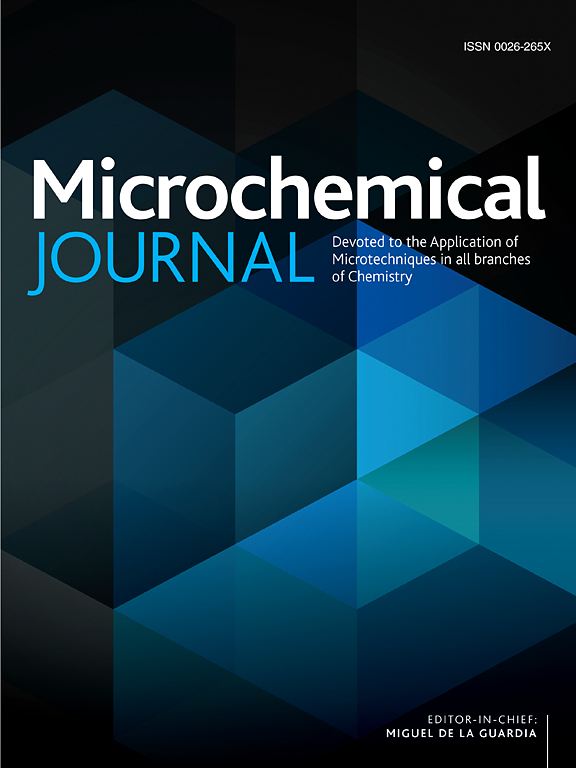IF 4.9
2区 化学
Q1 CHEMISTRY, ANALYTICAL
引用次数: 0
摘要
对苯二酚(HQ)和邻苯二酚(CC)被广泛应用于染料、制药、塑料工业等领域。然而,由于它们在生态环境中毒性高、降解性低,被公认为重要的环境污染物。因此,开发高灵敏度和简单的方法来检测它们是非常必要的。本研究以聚多巴胺(PDA)为模板和氮源,以硫代乙酰胺(TAA)为硫源,以钼酸钠为钼源,通过简单的超声和热解反应成功合成了一种新型掺杂钼、氮、硒的三维(3D)互连多孔碳球(Mo, N, S-IPCS)。制备的纳米球具有尺寸均匀的三维互连框架结构。这增加了材料的孔隙率,同时也确保了材料具有稳定的导电层。这种出色的独特结构使材料具有更高的催化活性和选择性。这种优秀的材料具有良好的应用前景。此外,该材料还在电极表面进行了修饰,成功实现了 HQ 和 CC 的电化学检测。Mo, N, S-IPCS/GCE 电极的循环伏安法(CV)显示出 HQ 和 CC 的两个独立而明显的准可逆氧化还原峰。用 i-t 法测定并计算出 HQ 的线性范围和 LOD 分别为 5.0 × 10-6 至 1.0 × 10-2 M 和 0.047 μM(S/N = 3)。CC 的线性范围和 LOD 分别为 5.0 × 10-8 至 2.0 × 10-3 M 和 0.018 μM (S/N = 3)。此外,该电化学传感器还成功应用于河水中 HQ 和 CC 的检测。本文章由计算机程序翻译,如有差异,请以英文原文为准。

A sensor based on Mo, N, S-doped interconnected porous carbon spheres material for simultaneous determination of hydroquinone and catechol
Hydroquinone (HQ) and catechol (CC) are widely used in dyes, pharmaceutical, plastic industries and other fields. However, they are recognized as important environmental pollutants because of their high toxicity and low degradation in the ecological environment. Therefore, the development of highly sensitive and simple methods for detecting of them is very necessary. In this present work, using polydopamine (PDA) as the template and nitrogen source, thioacetamide (TAA) as sulfur source and sodium molybdate as molybdenum source, a new type of Mo, N, S doped three-dimensional(3D) interconnected porous carbon sphere (Mo, N, S-IPCS) was successfully synthesized by simple ultrasonic and pyrolysis reactions. The prepared-nanosphere has an interconnected 3D frame structure with uniform size. This increases the porosity of the material while also ensuring that the material has a stable conductive layer. This excellent unique structure enables the material a higher catalytic activity and higher selectivity. This excellent material has a good application prospect. Moreover, the material was modified on the surface of the electrode, which successfully realized the electrochemical detection of HQ and CC. Cyclic voltammetry (CV) of Mo, N, S-IPCS/GCE electrode shows two independent and distinct quasi-reversible redox peaks of HQ and CC. With the i-t method, the linear ranges and LODs of HQ were determined and calculated to be 5.0 × 10−6 to 1.0 × 10−2 M and 0.047 μM (S/N = 3), respectively. And the linear ranges and LODs of CC were 5.0 × 10−8 to 2.0 × 10−3 M and 0.018 μM (S/N = 3), respectively. In addition, the electrochemical sensor was successfully applied to the detection of HQ and CC in river water.
求助全文
通过发布文献求助,成功后即可免费获取论文全文。
去求助
来源期刊

Microchemical Journal
化学-分析化学
CiteScore
8.70
自引率
8.30%
发文量
1131
审稿时长
1.9 months
期刊介绍:
The Microchemical Journal is a peer reviewed journal devoted to all aspects and phases of analytical chemistry and chemical analysis. The Microchemical Journal publishes articles which are at the forefront of modern analytical chemistry and cover innovations in the techniques to the finest possible limits. This includes fundamental aspects, instrumentation, new developments, innovative and novel methods and applications including environmental and clinical field.
Traditional classical analytical methods such as spectrophotometry and titrimetry as well as established instrumentation methods such as flame and graphite furnace atomic absorption spectrometry, gas chromatography, and modified glassy or carbon electrode electrochemical methods will be considered, provided they show significant improvements and novelty compared to the established methods.
 求助内容:
求助内容: 应助结果提醒方式:
应助结果提醒方式:


